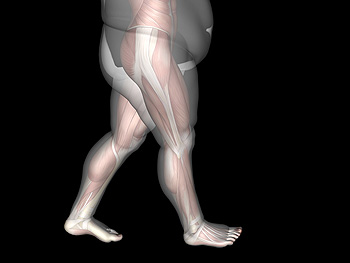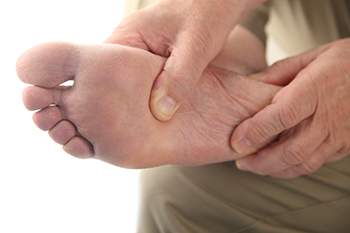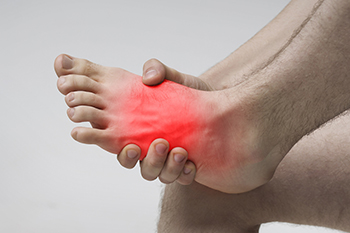Items filtered by date: August 2023
Obesity, Diabetes, and Foot Conditions

Diabetes affects many people and may cause health conditions like foot ulcers to develop. If left untreated, foot ulcers can become gangrenous and in severe cases, lead to amputation. Type 2, or adult-onset, diabetes, is often linked to obesity and lifestyle factors. Obese individuals with diabetes are more apt to find it challenging to maintain healthy lifestyles, including proper eating and exercise, and may need assistance. In addition to the psychological distress this condition causes, it can also severely impact one’s overall health. If you are obese or have diabetes, and it is affecting your feet, it is strongly suggested that you make an appointment with a podiatrist as soon as possible to get the care and support needed to maintain your health.
The more you weigh, the harder your feet must work to support your body. If you’re an obese individual and are concerned about your feet, contact Donald Manger, DPM from Associated Podiatric Physicians, PA. Our doctor can provide the care you need to keep you pain-free and on your feet.
Obesity and Your Feet
People who are overweight are putting more pressure on their ankles, knees, and hips as well as their feet. This unfortunately can lead to variety of different issues.
Problems & Complications Stemming from Obesity
- When the body is overweight, it tries to compensate by changing the way that it moves. An obese person may lean forward and put extra weight on the wrong part of the foot. This puts unnecessary stress on the feet.
- Obese people are also more likely to develop type II diabetes which is a condition that causes a lot of foot problems. People with diabetes often don’t feel the cuts and sores that they may have on their feet, which can lead to more complicated and severe issues.
- Plantar fasciitis is another foot condition that can be caused by obesity. Plantar fasciitis is an inflammation of the tissue along the bottom of the foot, which causes pain and stiffness while walking and climbing stairs.
If you have any questions, please feel free to contact our office located in Hamilton Township, NJ . We offer the newest diagnostic and treatment technologies for all your foot care needs.
Symptoms of Foot Problems in Children

A child's developing feet undergo significant changes during their early years. The medial arch, formed by bones, muscles, and ligaments, gradually takes shape, resulting in a visible arch in the sole. Infants and young children often have flat feet, which is normal due to their flexibility. As kids learn to walk, their ligaments and muscles strengthen, and the arch area becomes less pronounced. By around six years old, most children should have developed normal arches. If a child experiences foot pain or seems to struggle to keep up with peers, a problem may be developing. Two conditions, in-toeing, when the feet turn inwards, and out-toeing, when the feet turn outwards, may require attention. In many cases, in-toeing might resolve on its own, but a persistent or severe case should be assessed, especially if it hinders the child's gait or causes tripping. Out-toeing often resolves as posture and balance improve, but serious cases or those causing pain should be addressed. Parents should also be vigilant about other symptoms like abnormally shaped toes, ingrown toenails, bunions, stiffness, limping, and sudden gait changes. If your child's feet are raising concerns or causing pain, it is suggested that you make an appointment with a podiatrist.
The health of a child’s feet is vital to their overall well-being. If you have any questions regarding foot health, contact Donald Manger, DPM of Associated Podiatric Physicians, PA. Our doctor can provide the care you need to keep you pain-free and on your feet.
Tips for Keeping Children's Feet Healthy
- Make sure their shoes fit properly
- Look for any signs of in-toeing or out-toeing
- Check to see if they have Clubfoot (condition that affects your child’s foot and ankle, twisting the heel and toes inward) which is one of the most common nonmajor birth defects.
- Lightly cover your baby’s feet (Tight covers may keep your baby from moving their feet freely, and could prevent normal development)
- Allow your toddler to go shoeless (Shoes can be restricting for a young child’s foot)
- Cut toenails straight across to avoid ingrown toenails
- Keep your child’s foot clean and dry
- Cover cuts and scrapes. Wash any scratches with soap and water and cover them with a bandage until they’ve healed.
If you have any questions, please feel free to contact our office located in Hamilton Township, NJ . We offer the newest diagnostic and treatment technologies for all your foot care needs.
Are Bunions Affecting Your Everyday Life?
The Effects of Diabetes on the Feet

Diabetes has a profound impact on foot health, making it crucial for individuals with this condition to manage their blood sugar levels effectively. Elevated blood sugar can lead to reduced blood flow in the feet, resulting in serious complications. Diabetic neuropathy is a common condition, causing tingling sensations and pain in the feet. Nerve damage can lead to unnoticed injuries, which may worsen due to lack of sensation, which may eventually result in gangrene. Peripheral vascular disease, caused by restricted blood flow, is also a concern. Charcot foot, a rare condition, can deform the foot and raise the risk of sores. Monitoring foot health, managing blood sugar, and seeking early treatment are essential to prevent severe complications and ensure better overall well-being for individuals with diabetes. If you have diabetes and are experiencing foot problems, it is strongly suggested that you make an appointment with a podiatrist for regular examinations and needed treatment.
Diabetic foot care is important in preventing foot ailments such as ulcers. If you are suffering from diabetes or have any other concerns about your feet, contact Donald Manger, DPM from Associated Podiatric Physicians, PA. Our doctor can provide the care you need to keep you pain-free and on your feet.
Diabetic Foot Care
Diabetes affects millions of people every year. The condition can damage blood vessels in many parts of the body, especially the feet. Because of this, taking care of your feet is essential if you have diabetes, and having a podiatrist help monitor your foot health is highly recommended.
The Importance of Caring for Your Feet
- Routinely inspect your feet for bruises or sores.
- Wear socks that fit your feet comfortably.
- Wear comfortable shoes that provide adequate support.
Patients with diabetes should have their doctor monitor their blood levels, as blood sugar levels play such a huge role in diabetic care. Monitoring these levels on a regular basis is highly advised.
It is always best to inform your healthcare professional of any concerns you may have regarding your feet, especially for diabetic patients. Early treatment and routine foot examinations are keys to maintaining proper health, especially because severe complications can arise if proper treatment is not applied.
If you have any questions please feel free to contact our office located in Hamilton Township, NJ . We offer the newest diagnostic and treatment technologies for all your foot and ankle needs.
Torn Ligaments in the Ankle

The main job of the ankle joint is to help you move your foot up and down. The ankle joint connects the leg and foot and is basically held together with tendons and ligaments. These are strong bands of tissue that provide stability. A torn ligament in the ankle can be caused by a twisting action, which stretches the ankle beyond its normal range. There are three categories of ligament tears, which depend on the severity of the injury. A grade 1 injury is deemed a minor, or micro, tear of the ligament. A grade 2 injury refers to a partial tear and may result in a loosening of the tissue. For these two types of injuries, rest and a type of brace or immobilizing device may be needed. A grade 3 injury is a complete tear of the ligament, however, and it almost always calls for surgical intervention to correct it. A podiatrist can determine the severity of the injury through imaging tests and based on that information prescribe the appropriate treatment program. For more information about a torn ankle ligament, it is suggested that you make an appointment with a podiatrist.
Ankle sprains are common but need immediate attention. If you need your feet checked, contact Donald Manger, DPM from Associated Podiatric Physicians, PA. Our doctor can provide the care you need to keep you pain-free and on your feet.
How Does an Ankle Sprain Occur?
Ankle sprains take place when the ligaments in your ankle are torn or stretched beyond their limits. There are multiple ways that the ankle can become injured, including twisting or rolling over onto your ankle, putting undue stress on it, or causing trauma to the ankle itself.
What Are the Symptoms?
- Mild to moderate bruising
- Limited mobility
- Swelling
- Discoloration of the skin (depending on severity)
Preventing a Sprain
- Wearing appropriate shoes for the occasion
- Stretching before exercises and sports
- Knowing your limits
Treatment of a Sprain
Treatment of a sprain depends on the severity. Many times, people are told to rest and remain off their feet completely, while others are given an air cast. If the sprain is very severe, surgery may be required.
If you have suffered an ankle sprain previously, you may want to consider additional support such as a brace and regular exercises to strengthen the ankle.
If you have any questions please feel free to contact our office located in Hamilton Township, NJ . We offer the newest diagnostic and treatment technologies for all your foot and ankle needs.
Stress Fractures in the Feet

Dancers and basketball players, as well as runners, may be familiar with stress fractures in the feet. This overuse injury, which consists of hairline fractures of the bones in the foot, often results from repetitive pounding on hard surfaces. A sudden increase in activity, such as playing longer and more often, or adding excess mileage to a run, can result in developing stress fractures. These tiny cracks are easy to dismiss at first because the pain often diminishes with rest. They also are difficult to detect with a foot X-ray, and often may only be noticed through digital imaging tests. Certain types of footwear, exercise equipment and surfaces, as well as insufficient rest periods are other major contributors to foot stress fractures. Finally, osteoporosis, arthritis, and neuropathy can be factors. A podiatrist can offer a clear diagnosis of stress fractures, and depending on the severity can offer the appropriate treatment options. For more information, it is suggested that you make an appointment with a podiatrist.
Activities where too much pressure is put on the feet can cause stress fractures. To learn more, contact Donald Manger, DPM from Associated Podiatric Physicians, PA. Our doctor can provide the care you need to keep your pain free and on your feet.
Dealing with Stress Fractures of the Foot and Ankle
Stress fractures occur in the foot and ankle when muscles in these areas weaken from too much or too little use. The feet and ankles then lose support when walking or running from the impact of the ground. Since there is no protection, the bones receive the full impact of each step. Stress on the feet can cause cracks to form in the bones, thus creating stress fractures.
What Are Stress Fractures?
Stress fractures occur frequently in individuals whose daily activities cause great impact on the feet and ankles. Stress factors are most common among:
- Runners
- People affected with Osteoporosis
- Tennis or basketball players
- Gymnasts
- High impact workouts
Symptoms
Pain from the fractures occur in the area of the fractures and can be constant or intermittent. It will often cause sharp or dull pain with swelling and tenderness. Engaging in any kind of activity which involves high impact will aggravate pain.
If you have any questions please feel free to contact our office located in Hamilton Township, NJ . We offer the newest diagnostic and treatment technologies for all your foot and ankle needs.

